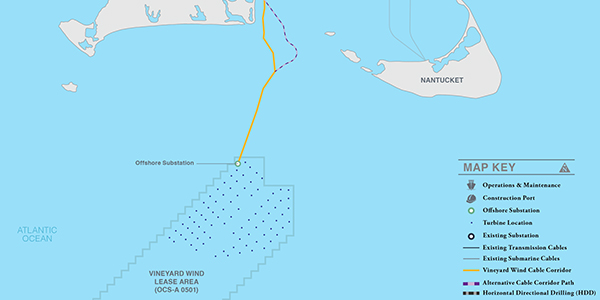Vineyard Wind announced Wednesday that it reached a transmission agreement with ISO-NE to deliver power to the RTO’s grid from Vineyard Wind 1, the first large-scale offshore wind project in the U.S.
A joint venture of Avangrid Renewables and Denmark’s Copenhagen Infrastructure Partners, Vineyard is building the 800-MW wind farm 15 miles off the coast of Martha’s Vineyard, Mass.
Vineyard said the agreement would provide “clean, renewable and cost-effective energy” for more than 400,000 homes and businesses across Massachusetts and reduce carbon emissions by more than 1.6 million tons per year.
“We’re very pleased to reach this agreement, another important milestone in a project that will bring an entirely new industry to the U.S.,” Vineyard Wind Deputy CEO Sy Oytan said in a statement. “There is tremendous potential for job creation, not just during construction but also for operations and maintenance. These are good-paying jobs that will be around for decades to come.”
In September, FERC approved the company’s execution of the interconnection agreement with the RTO, effective July 10. The agreement allows Vineyard Wind 1 to interconnect at the 115-kV Barnstable switch station on Cape Cod. Vineyard was selected to enter into power purchase agreements with electric distribution companies as part of the Massachusetts Green Communities Act offshore wind solicitation.
At FERC’s technical conference on OSW transmission Tuesday, Al McBride, director of transmission services and resource qualification, said there is room for the region’s power system to accommodate the initial wave of projects, but connecting further projects would be more expensive as this “low-hanging fruit” is used on the transmission system.
ISO-NE spokesperson Matt Kakley said Wednesday that McBride’s observation reflected the 2019 Economic Studies for the New England States Committee on Electricity and Anbaric Development Partners. It estimated that injecting 7,000 MW of OSW capacity at optimal locations could avoid significant reinforcements to the 345-kV transmission system. Injections above 7,000 MW would require additional power plant retirements or support to the onshore transmission system, the report concluded.
“We’re looking forward to discussing with the New England states and market participants how to best shape the development of the regional grid to accommodate regional policy goals, under the authority provided by the ISO’s tariff and under any needed enhancements to the ISO’s planning scope.” Kakley said.
Speakers at the technical conference said the efficient development of offshore transmission will require changes to current planning, interconnection and cost allocation procedures. (See related story, FERC Pushed to Change Tx Rules for OSW.)
A white paper released Monday by the Business Network for Offshore Wind stated that RTO processes fail to capture all the benefits from offshore transmission, particularly an interregional network that could improve ISO-NE resilience. (See OSW Group Seeks Changes on Tx Planning, Cost Allocation.)



